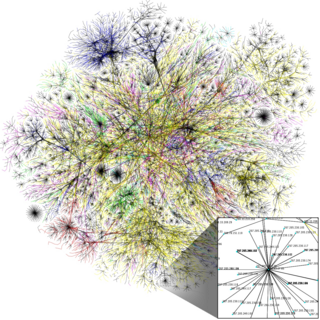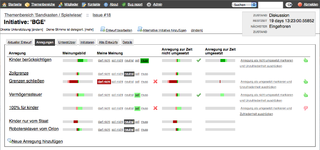Participatory democracy or participant democracy is a form of government in which citizens participate individually and directly in political decisions and policies that affect their lives, rather than through elected representatives. Elements of direct and representative democracy are combined in this model.

Science and technology studies (STS) is an interdisciplinary field that examines the creation, development, and consequences of science and technology in their historical, cultural, and social contexts.

Citizen Participation or Public Participation in social science refers to different mechanisms for the public to express opinions—and ideally exert influence—regarding political, economic, management or other social decisions. Participatory decision-making can take place along any realm of human social activity, including economic, political, management, cultural or familial.

E-democracy, also known as digital democracy or Internet democracy, is the use of information and communication technology (ICT) in political and governance processes. The term is believed to have been coined by digital activist Steven Clift. E-democracy incorporates 21st-century information and communications technology to promote democracy; such technologies include civic technology and government technology. It is a form of government in which all adult citizens are presumed to be eligible to participate equally in the proposal, development and creation of laws.
The ethics of technology is a sub-field of ethics addressing the ethical questions specific to the Technology Age, the transitional shift in society wherein personal computers and subsequent devices provide for the quick and easy transfer of information. Technology ethics is the application of ethical thinking to the growing concerns of technology as new technologies continue to rise in prominence[1].

Participatory budgeting (PB) is a type of citizen sourcing in which ordinary people decide how to allocate part of a municipal or public budget through a process of democratic deliberation and decision-making. Participatory budgeting allows citizens or residents of a locality to identify, discuss, and prioritize public spending projects, and gives them the power to make real decisions about how money is spent.
Public awareness of science (PAwS) is everything relating to the awareness, attitudes, behaviors, opinions, and activities that comprise the relations between the general public or lay society as a whole to scientific knowledge and organization. This concept is also known as public understanding of science (PUS), or more recently, public engagement with science and technology (PEST). It is a comparatively new approach to the task of exploring the multitude of relations and linkages science, technology, and innovation have among the general public. While early work in the discipline focused on increasing or augmenting the public's knowledge of scientific topics, in line with the information deficit model of science communication, the deficit model has largely been abandoned by science communication researchers. Instead, there is an increasing emphasis on understanding how the public chooses to use scientific knowledge and on the development of interfaces to mediate between expert and lay understandings of an issue. Newer frameworks of communicating science include the dialogue and the participation models. The dialogue model aims to create spaces for conversations between scientists and non-scientists to occur while the participation model aims to include non-scientists in the process of science.
Electronic participation (e-participation) is the term referring to ICT-supported participation in processes involving government and citizens. Processes may concern administration, service delivery, decision making and policy making. E-participation is hence closely related to e-government and e-governance participation. The need for the term has emerged as citizen interests and interaction with political service providers have increasingly become digitized due to the rise of e-government.
Public engagement or public participation is a term that has recently been used to describe "the practice of involving members of the public in the agenda-setting, decision-making, and policy-forming activities of organizations/institutions responsible for policy development." It is focused on the participatory actions of the public to aid in policy making based in their values.
Radical democracy is a type of democracy that advocates the radical extension of equality and liberty. Radical democracy is concerned with a radical extension of equality and freedom, following the idea that democracy is an unfinished, inclusive, continuous and reflexive process.

Science communication is the practice of informing, educating, raising awareness of science-related topics, and increasing the sense of wonder about scientific discoveries and arguments. Science communicators and audiences are ambiguously defined and the expertise and level of science knowledge varies with each group. Two types of science communication are outward-facing or science outreach and inward-facing or science "inreach". Examples of outreach include science journalism and science museums. Examples of inreach include scholarly communication and publication in scientific journals. Society

Liquid democracy is a form of delegative democracy whereby an electorate engages in collective decision-making through direct participation and dynamic representation. This democratic system utilizes elements of both direct and representative democracy. Voters in a liquid democracy have the right to vote directly on all policy issues à la direct democracy, however, voters also have the option to delegate their votes to someone who will vote on their behalf à la representative democracy. Any individual may be delegated votes and these proxies may in turn delegate their vote as well as any votes they have been delegated by others resulting in "metadelegation".
Participative decision-making (PDM) is the extent to which employers allow or encourage employees to share or participate in organizational decision-making. According to Cotton et al., the format of PDM could be formal or informal. In addition, the degree of participation could range from zero to 100% in different participative management (PM) stages.

Collaborative e-democracy is a democratic conception that combines key features of direct democracy, representative democracy, and e-democracy. The concept was first published at two international academic conferences in 2009.
Types of democracy refers to pluralism of governing structures such as governments and other constructs like workplaces, families, community associations, and so forth. Types of democracy can cluster around values. For example, some like direct democracy, electronic democracy, participatory democracy, real democracy, deliberative democracy, and pure democracy strive to allow people to participate equally and directly in protest, discussion, decision-making, or other acts of politics. Different types of democracy - like representative democracy - strive for indirect participation as this procedural approach to collective self-governance is still widely considered the only means for the more or less stable democratic functioning of mass societies. Types of democracy can be found across time, space, and language. In the English language the noun "democracy" has been modified by 2,2,3,4 adjectives. These adjectival pairings, like atomic democracy or Zulu democracy, act as signal words that point not only to specific meanings of democracy but to groups, or families, of meaning as well.
Open-source political campaigns,open-source politics, or Politics 2.0, is the idea that social networking and e-participation technologies will revolutionize our ability to follow, support, and influence political campaigns. Netroots evangelists and web consultants predict a wave of popular democracy as fundraisers meet on MySpace or Facebook, YouTubers crank out attack ads and bloggers do opposition research.

A citizens' assembly is a body formed from randomly selected citizens to deliberate on important issues.

LiquidFeedback is free software for political opinion formation and decision making, combining aspects of representative and direct democracy. Its most important feature is the implementation of a delegated voting system which is to establish a new form of political representation and participation that takes into account the knowledge disparity of its participants. The software offers much promise but also faces many threats.
Democratization of technology refers to the process by which access to technology rapidly continues to become more accessible to more people. New technologies and improved user experiences have empowered those outside of the technical industry to access and use technological products and services. At an increasing scale, consumers have greater access to use and purchase technologically sophisticated products, as well as to participate meaningfully in the development of these products. Industry innovation and user demand have been associated with more affordable, user-friendly products. This is an ongoing process, beginning with the development of mass production and increasing dramatically as digitization became commonplace.
Politics and technology encompasses concepts, mechanisms, personalities, efforts, and social movements that include, but are not necessarily limited to, the Internet and other information and communication technologies (ICTs). Scholars have begun to explore how internet technologies influence political communication and participation, especially in terms of what is known as the public sphere.








